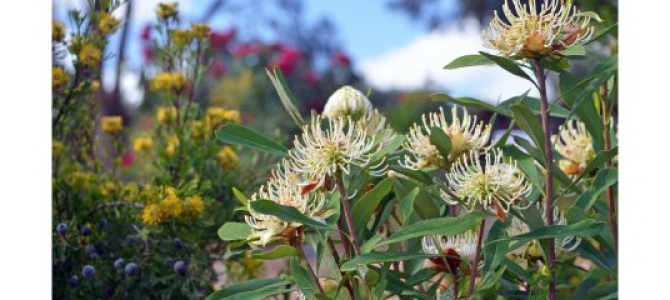 Shopping Cart
Shopping Cart
04 August 2023
How to Create a Water-Saving Garden: A Step-by-Step Guide

Are you concerned about the rising cost of water bills and the impact of excessive water usage on the environment? Look no further!
In this step-by-step guide, we will show you how to create a water-saving garden that not only helps you save money but also contributes to a greener planet.
By making a few simple adjustments to your outdoor space, you can significantly reduce your water consumption without sacrificing the beauty and vitality of your garden.
From choosing drought-resistant plants to implementing efficient irrigation systems, we will provide you with practical tips and insights to create a sustainable garden that thrives with minimal water.
The importance of water-saving gardens
Water scarcity is a global concern, and it's more important than ever to conserve water in our daily lives. One area where we can make a significant impact is in our gardens. Water-saving gardens are designed to minimise water usage while still maintaining a lush and vibrant landscape.
By reducing the amount of water we use for irrigation, we can help alleviate the strain on the water supply and reduce the environmental impact of excessive water consumption.
Benefits of water-saving gardens
Water-saving gardens are not only beneficial for the planet but also for our wallets, as they can lead to substantial savings on water bills. So, let's explore the benefits of water-saving gardens in more detail.
Environmental benefits
Water-saving gardens help conserve water by reducing the need for excessive irrigation. By choosing plants that are well-suited to your local climate and soil conditions, you can minimise water waste and promote sustainable gardening practices. Additionally, water-saving gardens contribute to the overall health of the ecosystem by reducing runoff and soil erosion, which can have a detrimental impact on nearby water bodies.
Financial benefits
Implementing water-saving techniques in your garden can lead to significant cost savings on your water bills. By optimising irrigation systems and using water-efficient practices, you can reduce water consumption without sacrificing the beauty and vitality of your garden. Over time, these savings can add up and make a noticeable difference in your household budget.
Low maintenance
Water-saving gardens are designed to be low-maintenance, requiring less time and effort to maintain their beauty. By selecting plants that are well-suited to your local climate and soil conditions, you can create a garden that thrives with minimal water and care. This not only saves you time but also reduces the need for chemical fertilisers and pesticides, promoting a healthier and more sustainable garden ecosystem.
Assessing your garden's water needs
Before you can start creating a water-saving garden, it's important to assess your garden's water needs. Understanding how much water your plants require will help you determine the most efficient irrigation methods and ensure that you're not overwatering or underwatering your garden. Here are a few steps to help you assess your garden's water needs:
1. Know your soil: Different soil types have varying water-holding capacities. Sandy soils, for example, drain water quickly, while clay soils retain moisture for longer periods. By understanding your soil type, you can determine how often and how much water your plants need.
2. Consider local climate: The climate in your region plays a significant role in determining how much water your garden requires. If you live in a hot and dry climate, you'll need to choose plants that are more drought-tolerant and adjust your watering schedule accordingly.
3. Observe your plants: Pay attention to how your plants respond to watering. If you notice wilting or yellowing leaves, it may be a sign of overwatering or underwatering. Adjust your watering schedule accordingly to ensure your plants receive the right amount of water.
By assessing your garden's water needs, you can tailor your water-saving strategies to meet the specific requirements of your plants and ensure optimal growth and health.
Choosing drought-tolerant plants
One of the key elements of a water-saving garden is selecting plants that are well-adapted to your local climate and require minimal irrigation. Drought-tolerant plants are capable of surviving and thriving with limited water resources, making them an excellent choice for water-saving gardens. Here are some tips for choosing drought-tolerant plants:
· Research local native plants: Native plants are naturally adapted to the local climate and soil conditions, making them more drought-tolerant and resilient. Research native plant species in your area and incorporate them into your garden to reduce water requirements. Here in New Zealand, we have a huge range of native plants that are drought-resistant that are perfect for water-saving gardens.
· Consider succulents and cacti: Succulents and cacti are excellent choices for water-saving gardens. These plants have adapted to arid conditions and have built-in water storage systems, allowing them to survive with minimal irrigation.
· Choose plants with low water requirements: Look for plants that have low water requirements and are well-suited to your garden's microclimate. Grouping plants with similar water needs together can also help optimise irrigation and reduce water waste.
By choosing drought-tolerant plants, you can create a beautiful and sustainable garden that thrives with minimal water.
Watering techniques for water-saving gardens
Efficient watering techniques are essential for water-saving gardens. By optimising your irrigation methods, you can minimise water waste and ensure that your plants receive the right amount of water. Here are some water-saving watering techniques to consider:
1. Water deeply and infrequently: Instead of frequent shallow watering, water your plants deeply and infrequently. This encourages deep root growth and reduces water evaporation from the soil surface.
2. Water in the morning: Watering your plants in the early morning allows them to absorb water before the heat of the day evaporates it. This maximises water uptake and reduces the risk of fungal diseases.
3. Use drip irrigation: Drip irrigation systems deliver water directly to the base of plants, minimising water waste through evaporation and runoff. This targeted approach ensures that water is delivered where it's needed most, reducing water consumption.
By implementing efficient watering techniques, you can optimise water usage in your garden and promote healthy plant growth.
Mulching for water conservation
Mulching is a simple yet effective technique for water conservation in water-saving gardens. By applying a layer of organic mulch around your plants, you can reduce water evaporation, suppress weed growth, and improve soil moisture retention.
Use organic mulch, such as wood chips, straw, or compost, to provide the best water conservation benefits. Organic mulch breaks down over time, adding nutrients to the soil and improving its structure.
You should apply a thick layer of mulch around your plants, ensuring a thickness of at least 2-3 inches. This helps insulate the soil, reducing temperature fluctuations and minimising water evaporation.
Make sure you leave a small gap between the mulch and the stems of your plants to prevent moisture buildup and potential rotting.
By incorporating mulching into your water-saving garden, you can conserve water, improve soil health, and enhance the overall aesthetics of your outdoor space.
Rainwater harvesting for water-saving gardens
Rainwater harvesting is an excellent way to supplement your water supply in water-saving gardens. By collecting rainwater, you can reduce reliance on municipal water sources and utilise a free and sustainable water source for your garden. Here are some methods of rainwater harvesting to consider:
· Rain barrels: Install rain barrels or cisterns to collect rainwater from your roof. These containers can be connected to downspouts and equipped with filters to catch and store rainwater for later use in your garden.
· Rain gardens: Design a rain garden to capture and utilise excess rainwater. A rain garden is a shallow depression in the ground that is planted with water-loving plants. It allows rainwater to naturally infiltrate the soil and replenish groundwater supplies.
· Swales and contouring: Create swales or contour your garden to direct rainwater runoff to areas where it's needed most. This helps maximise water absorption and reduces runoff, preventing erosion and water wastage.
Of course, rainwater harvesting can go far beyond just collecting rainwater for your garden. Here at Smart Water, we are helping to facilitate the management and monitoring of rainwater harvesting through our innovative water tank level monitoring system. Our market-leading product provides a wireless water tank management solution with mobile app connectivity, allowing you to manage and monitor the water you harvest from anywhere.
Large rainwater tanks can be used to collect rainwater from your roof that can be used for watering your plants all year round as well as providing a sustainable supply of water for both potable and non-potable uses around the home.
By harnessing the power of rainwater, you can reduce your reliance on traditional water sources and create a more sustainable and water-efficient garden.
Maintenance tips for water-saving gardens
Maintaining a water-saving garden requires some ongoing care and attention. By following these maintenance tips, you can ensure that your garden continues to thrive while minimising water usage:
1. Monitor soil moisture: Regularly check the moisture levels in your soil to ensure that your plants have adequate water. Avoid overwatering, as this can lead to root rot and other plant diseases.
2. Inspect irrigation systems: Regularly inspect and maintain your irrigation systems to ensure they are functioning properly. Repair any leaks or damaged sprinkler heads, and adjust the watering schedule as needed.
3. Remove weeds: Weeds compete with your plants for water and nutrients. Regularly remove weeds to reduce water competition and promote the health of your garden.
4. Prune and trim: Prune and trim your plants as needed to promote healthy growth and prevent overcrowding. This allows for better air circulation and reduces the risk of disease.
By incorporating these maintenance tips into your gardening routine, you can enjoy a thriving water-saving garden that requires minimal water and care.
Summary
Creating a water-saving garden is a rewarding endeavour that allows you to save money and contribute to a greener planet.
By implementing the step-by-step guide outlined in this article, you can create a sustainable garden that thrives with minimal water while still maintaining its beauty and vitality.
From choosing drought-tolerant plants to implementing efficient watering techniques and utilising rainwater, every step towards water conservation makes a difference.
So, let's take action and embrace the joy of creating a water-saving garden that is both eco-friendly and aesthetically pleasing. Together, we can save money and the planet, one garden at a time.
Frequently Asked Questions
What are the most effective methods for conserving water in a garden?
Water conservation in gardens can be achieved through several techniques, including selecting drought-tolerant plants, using efficient irrigation methods such as drip irrigation, mulching to retain soil moisture, and harvesting rainwater. Combining these strategies helps reduce water consumption while maintaining a healthy garden.
How does mulching contribute to water efficiency in gardens?
Mulching reduces water evaporation from the soil, suppresses weed growth, and improves soil moisture retention. Applying a thick layer of organic mulch, such as wood chips or straw, insulates the soil and gradually adds nutrients as it decomposes, supporting plant health with minimal water usage.
What role does rainwater harvesting play in creating a sustainable garden?
Rainwater harvesting provides an alternative water source, reducing reliance on municipal supplies. Techniques such as rain barrels, rain gardens, and contouring swales capture and direct rainwater for irrigation. When combined with monitoring systems, it ensures efficient use of collected water and supports year-round garden sustainability.
